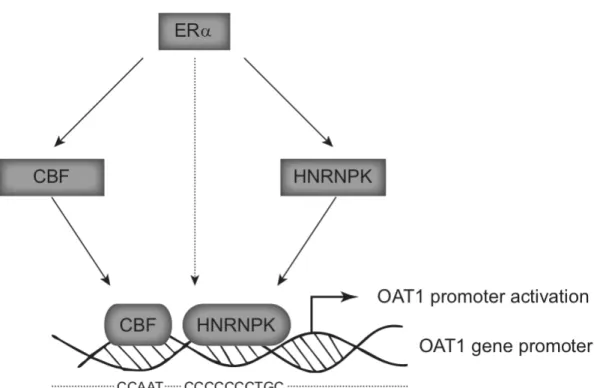Anna Maria Euteneuer – Involvement of estrogen receptor in transcriptional regulation of renal organic anion transporter 1 (OAT1) and OAT3
Tag der mündlichen Prüfung: 27.11.2018
Kurzzusammenfassung
Organische Anionen Transporter 1 (OAT1) und OAT3 sind polyspezifische Transportproteine, die in der basolateralen Membran proximaler Tubuluszellen in den Nieren lokalisiert sind.
OAT1 und OAT3 tragen maßgeblich zur Ausscheidung von Medikamenten bei. Unerwünschte Arzneimittelwechselwirkungen und Nebenwirkungen treten häufiger bei Frauen als bei Männern auf. Nebenwirkungen bei Frauen werden auch dann häufiger beobachtet, wenn es sich bei den eingenommenen Medikamenten um sogenannte OAT1/OAT3-Substrate handelt.
Geschlechtsspezifische Expression von Oat1 und Oat3 wurde bereits in Versuchstieren nachgewiesen. Dabei wurde gezeigt, dass Oat1 und Oat3 höher in männlichen als in weiblichen Tieren exprimiert sind. Über die trankriptionelle Regulation dieser Transportproteine im Menschen und Tier hingegen ist wenig bekannt. In dieser Doktorarbeit wurde die transkriptionelle Regulation von Oat1 und Oat3 bei Ratten sowie von OAT1 und OAT3 bei Menschen untersucht. Insbesondere wurde erstmalig der Effekt von Östrogenrezeptor (ER) auf die Promotoraktivität von Ratten und humanen Oat1/OAT1 und Oat3/OAT3 getestet. Zudem wurde erstmalig ein möglicher kooperativer Effekt des geschlechtsspezifischen Transkriptionsfaktors B-cell CLL/lymphoma 6 (BCL6) mit Androgen Rezeptor (AR), und mit hepatocyte nuclear factor 4a (HNF4a) auf OAT1 Promotoraktivität untersucht. Außerdem wurde eine mögliche geschlechtsspezifische renale Expression von OAT1 und OAT3 in humanen Nierenproben untersucht.
Promotoraktivierung von OATs wurde mit Hilfe von Luciferase Assay in transfizierten Opossum kidney (OK) Zellen gemessen. OK Zellen wurden mit Oat1-/OAT1- und Oat3-/OAT3- Promotorkonstrukten sowie Expressionsvektoren für BCL6, HNF4a, AR, ERa und ERb transfiziert, anschließend mit 100 nM Testosteron oder 17b-Estradiol inkubiert und analysiert.
Humane OAT1 und OAT3 mRNA Expression wurde in tumorfreiem, Formalin-fixierten Paraffin-eingebetteten renalen Gewebe von männlichen und weiblichen Patienten analysiert.
Co-Transfektion von BCL6 mit HNF4a oder AR zeigte keine Veränderung der Promotoraktivität von OAT1. Ratten Oat1 und humaner OAT3 Promotor wurden nicht durch Östrogen-ERa/b-Komplexe aktiviert. Im Gegensatz dazu wurde die Promotoraktivität von Ratten Oat3 und humanem OAT1 signifikant durch ERa erhöht. Die Promotoraktivierung wird jedoch nicht durch direkte Bindung des Östrogen-ERa-Komplexes an dem OAT1 Promotor initiiert. Unsere Daten zeigen, dass ERa die Expression der Transkriptionsfaktoren CCAAT-
box-binding transcription factor (CBF) und heterogeneous nuclear ribonucleoprotein K (HNRNPK) erhöht, die folglich an den OAT1 Promoter binden und diesen aktivieren.
Des Weiteren wurde keine geschlechtsspezifische Expression von OAT1 und OAT3 in humanen Nierenproben identifiziert.
Unsere Daten zeigen zum ersten Mal, dass OAT1 auch durch ERa aktiviert werden kann. Wir beschreiben einen neuen molekularen Mechanismus, der die ERa-abhängigen Transkriptionsfaktoren CBF und HNRNPK beinhaltet und zeigen somit neue Anhaltspunkte für eine geschlechtsspezifische, transkriptionelle Regulation der polyspezifischen Transportproteine.
Abstract
Organic anion transporter 1 (OAT1) and OAT3 are polyspecific transport proteins located in the basolateral membrane of renal proximal tubule cells. OAT1 and OAT3 play a pivotal role in drug clearance. Adverse drug reactions (ADR) are observed more frequently in women than in men, especially ADR are higher for drugs which are known interactors of OAT1 and OAT3.
Sex-dependent expressions of Oat1 and Oat3 have been observed in animals with a tendency to male-dominant expression. However, little is known on the regulatory level. This PhD thesis aims at elucidating the transcriptional regulation of rat and human Oat1/OAT1 and Oat3/OAT3 and tests effect of estrogen receptor (ER) for the first time. Furthermore, the effect of the renal male-dominant transcription factor B-cell CLL/lymphoma 6 (BCL6) combined with androgen receptor (AR) or hepatocyte nuclear factor 4a (HNF4a) was tested. Moreover, a possible sex- dependent expression of OAT1 and OAT3 in human kidney samples was investigated.
Promoter activation of OATs was assessed by luciferase assays carried out by transiently transfected Opossum kidney (OK) cells with promoter constructs of rat Oat1/Oat3, human OAT1/OAT3 and expression vectors for BCL6, HNF4a, AR, ERa and ERb, and after exposure to 100 nM testosterone or 17b-estradiol. Human OAT1 and OAT3 expression was measured in non-tumorous formalin-fixed, paraffin-embedded (FFPE) renal tissue of female and male patients who underwent oncological kidney resection.
Co-transfection of BCL6 and AR or HNF4a showed no additive effect on OAT1 promoter activity. Rat Oat1 and human OAT3 promoter activity was not affected by ligand activated ER.
In contrast, rat Oat3 and human OAT1 were significantly activated by ligand activated ERa.
However, activation occurred without a direct interaction of ERa with the OAT1 promoter. Our data show, activation of the transcription factors CCAAT-box-binding transcription factor (CBF) and heterogeneous nuclear ribonucleoprotein K (HNRNPK) by ERa which in turn bind and initiate OAT1 promoter activity. Furthermore, no sex-dependent expression of human OAT1 and OAT3 could be determined in the collected kidney samples. Our data show for the first
time estrogen-induced OAT1 transcriptional activation. We propose a new molecular mechanism including the estrogen-induced transcription factors CBF and HNRNPK providing new evidence of sex-dependent, transcriptional regulation of polyspecific drug transporters.
Graphical abstract of key finding
Figure 1 Proposed new mechanism of OAT1 promoter activation
OAT1 gene promoter is indirectly activated by ligand activated estrogen receptor (ERa). ERa initiates an increase in CBF and HNRNPK protein expression and activity which in turn bind to distinct regions in human OAT1 promoter leading to initiation of gene transcription.
